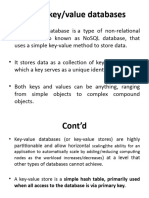0% found this document useful (0 votes)
41 views5 pagesKey-Value Databases Guide
The document discusses key-value databases, including what they are, how they work under the hood, common use cases, and comparisons to other database types. Key-value databases store data as unique keys mapped to data values, providing simple and fast retrieval of data without complex queries. They are well-suited for large volumes of small reads/writes, caching, and other use cases requiring high performance and scalability.
Uploaded by
Nam LươngCopyright
© © All Rights Reserved
We take content rights seriously. If you suspect this is your content, claim it here.
Available Formats
Download as DOCX, PDF, TXT or read online on Scribd
0% found this document useful (0 votes)
41 views5 pagesKey-Value Databases Guide
The document discusses key-value databases, including what they are, how they work under the hood, common use cases, and comparisons to other database types. Key-value databases store data as unique keys mapped to data values, providing simple and fast retrieval of data without complex queries. They are well-suited for large volumes of small reads/writes, caching, and other use cases requiring high performance and scalability.
Uploaded by
Nam LươngCopyright
© © All Rights Reserved
We take content rights seriously. If you suspect this is your content, claim it here.
Available Formats
Download as DOCX, PDF, TXT or read online on Scribd
/ 5






















































































